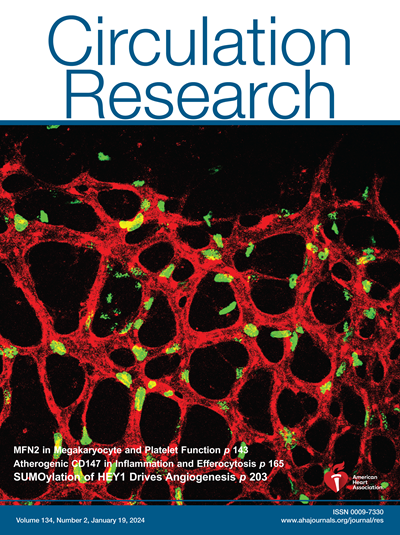Adaptation to Elevated Mitochondrial Calcium Is Distinct in the Left and Right Ventricles.
IF 16.2
1区 医学
Q1 CARDIAC & CARDIOVASCULAR SYSTEMS
引用次数: 0
Abstract
BACKGROUND Mitochondrial ATP production, essential for cardiomyocyte function, is regulated by mitochondrial Ca2+ (mtCa2+). The primary route for mtCa2+ influx is the mitochondrial calcium uniporter complex. The mitochondrial calcium uniporter complex subunit MICU (mitochondrial calcium uptake) 1 limits mtCa2+ uptake, preventing mtCa2+ overload. Although elevated mtCa2+ has been observed in multiple diseases including heart failure, its effects on heart function remain elusive. METHODS To investigate the impact of elevated mtCa2+ in adult hearts, we generated a mouse model with cardiomyocyte-specific tamoxifen-inducible Micu1 deletion (Micu1cKO). Cardiac function was assessed through echocardiography. Mitochondria, adult cardiomyocytes, and tissue extracts were isolated from the left ventricle (LV) and right ventricle (RV) for comprehensive analysis at multiple time points ranging from 1 to 9 weeks post-tamoxifen injection. RESULTS Acute MICU1 deficiency resulted in increased mtCa2+ accompanied by reduced mitochondrial respiration in both the RV and LV. Contractile function, which was diminished in both ventricles initially, remained reduced in the RV upon prolonged MICU1 deficiency. In contrast, the LV exhibited signs of recovery over time, including restored ejection fraction concurrent with normalization of mtCa2+ levels. This pattern was mirrored in cardiomyocyte contractility. In Micu1cKO RV, mtCa2+ remained elevated, likely contributing to oxidative stress. As a potential mechanism underlying LV-specific recovery, EMRE (essential MCU regulator), an mitochondrial calcium uniporter complex subunit that promotes mtCa2+ uptake, was found to be downregulated only in the LV. This suggested that the LV initiated a compensatory response to elevated mtCa2+, while the RV remained impacted. Supporting this, proteomics analysis indicated a divergent proteomic signature in Micu1cKO RV. Follow-up experiments suggested enhanced EMRE degradation in Micu1cKO LV mediated by m-AAA proteases through a PKA (protein kinase A)-regulated mechanism. In MICU1-deficient neonatal cardiomyocytes, pharmacological PKA inhibition was sufficient to decrease EMRE levels. Analysis of LV tissues from patients with dilated cardiomyopathy suggested that this pathway may be relevant in human DCM. CONCLUSIONS While elevated mtCa2+ disrupted cardiac function in both ventricles, it induced an LV-specific adaptive response that suppressed mtCa2+ intake, contributing to the recovery of mitochondrial and cardiac function. The absence of this pathway in the RV has implications for therapeutics targeting RV dysfunction, a key determinant of mortality in heart failure.左心室和右心室对线粒体钙升高的适应是不同的。
线粒体ATP的产生是心肌细胞功能所必需的,是由线粒体Ca2+ (mtCa2+)调节的。mtCa2+内流的主要途径是线粒体钙单转运复合物。线粒体钙单转运复合物亚基MICU(线粒体钙摄取)1限制mtCa2+摄取,防止mtCa2+过载。虽然在包括心力衰竭在内的多种疾病中观察到mtCa2+升高,但其对心功能的影响仍然难以捉摸。方法为了研究mtCa2+升高对成人心脏的影响,我们建立了心肌细胞特异性他莫昔芬诱导Micu1缺失(Micu1cKO)的小鼠模型。通过超声心动图评估心功能。在注射他莫昔芬后1 ~ 9周的多个时间点,分别从左心室(LV)和右心室(RV)分离线粒体、成体心肌细胞和组织提取物,进行综合分析。结果急性MICU1缺陷导致右心室和左心室mtCa2+升高,同时线粒体呼吸减少。最初两个心室的收缩功能减弱,在长时间MICU1缺乏后,右心室的收缩功能仍然降低。相反,随着时间的推移,左室表现出恢复的迹象,包括射血分数的恢复和mtCa2+水平的正常化。这种模式反映在心肌细胞的收缩性上。在Micu1cKO RV中,mtCa2+保持升高,可能有助于氧化应激。作为LV特异性恢复的潜在机制,EMRE(必需MCU调节剂),一种促进mtCa2+摄取的线粒体钙单转运复合物亚基,被发现仅在LV中下调。这表明左室启动了对mtCa2+升高的代偿反应,而右室仍然受到影响。蛋白质组学分析表明Micu1cKO RV具有不同的蛋白质组学特征。后续实验表明,m-AAA蛋白酶通过PKA(蛋白激酶a)调控的机制介导了Micu1cKO LV中EMRE的降解。在micu1缺陷的新生儿心肌细胞中,药理学PKA抑制足以降低EMRE水平。扩张型心肌病患者左室组织的分析表明,这一途径可能与人类DCM有关。结论:虽然mtCa2+升高会破坏两个心室的心功能,但它会诱导lv特异性的适应性反应,抑制mtCa2+的摄入,有助于线粒体和心功能的恢复。右心室中该通路的缺失对治疗右心室功能障碍具有重要意义,右心室功能障碍是心力衰竭死亡率的关键决定因素。
本文章由计算机程序翻译,如有差异,请以英文原文为准。
求助全文
约1分钟内获得全文
求助全文
来源期刊

Circulation research
医学-外周血管病
CiteScore
29.60
自引率
2.00%
发文量
535
审稿时长
3-6 weeks
期刊介绍:
Circulation Research is a peer-reviewed journal that serves as a forum for the highest quality research in basic cardiovascular biology. The journal publishes studies that utilize state-of-the-art approaches to investigate mechanisms of human disease, as well as translational and clinical research that provide fundamental insights into the basis of disease and the mechanism of therapies.
Circulation Research has a broad audience that includes clinical and academic cardiologists, basic cardiovascular scientists, physiologists, cellular and molecular biologists, and cardiovascular pharmacologists. The journal aims to advance the understanding of cardiovascular biology and disease by disseminating cutting-edge research to these diverse communities.
In terms of indexing, Circulation Research is included in several prominent scientific databases, including BIOSIS, CAB Abstracts, Chemical Abstracts, Current Contents, EMBASE, and MEDLINE. This ensures that the journal's articles are easily discoverable and accessible to researchers in the field.
Overall, Circulation Research is a reputable publication that attracts high-quality research and provides a platform for the dissemination of important findings in basic cardiovascular biology and its translational and clinical applications.
 求助内容:
求助内容: 应助结果提醒方式:
应助结果提醒方式:


